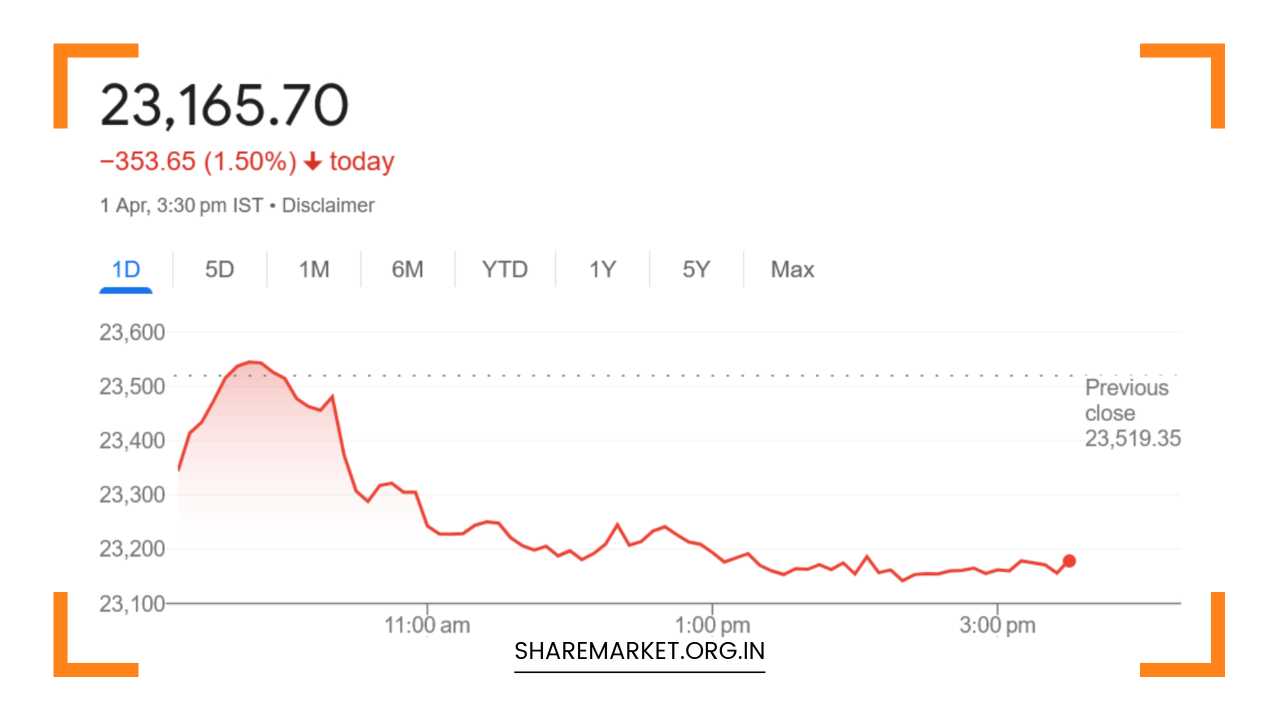Sensex Down 1,390 Points, Nifty at 23,165; Tomorrow Nifty Prediction

Tomorrow Nifty Prediction
Market Overview: Market Closes in Decline – Market Prediction for April 2
The Indian stock market closed with significant losses on April 1, extending the negative momentum for the second consecutive trading session.
This drop was marked by a decline in the benchmark indices, with the Nifty falling below the critical 23,200 level.
The Sensex closed at 76,024.51, shedding 1,390.41 points or 1.80% of its value, while the Nifty finished the day at 23,165.70, losing 353.65 points or 1.50%.
The market breadth was also skewed, with 2,651 stocks advancing, 1,230 declining, and 144 stocks remaining unchanged.
The sectoral performance highlighted a broader trend of weakness across multiple segments of the market.
While the Media, Oil & Gas, and Telecom sectors registered positive gains of 2%, 0.6%, and 2%, respectively, most other sectors closed in the red.
Notably, the IT, Realty, and Consumer Durables sectors experienced significant losses, with declines ranging from 2-3%.
The BSE Midcap index recorded a drop of 1%, while the Smallcap index remained largely flat, suggesting that small and mid-cap stocks also faced significant pressure during the trading session.
Key Movers and Shakers
Among the major stocks, the Nifty’s top losers were dominated by heavyweights such as HCL Technologies, Bajaj Finserv, HDFC Bank, Shriram Finance, and Bharat Electronics.
These stocks suffered considerable declines, contributing to the broader market drop. On the other hand, some stocks managed to buck the overall trend, with IndusInd Bank, Trent, Bajaj Auto, Jio Financial, and HDFC Life emerging as the top gainers.
The performance of these stocks reflects the market’s ongoing rotational trends, with certain sectors and stocks moving independently of the broader market sentiment.
While the broader market showed mixed performance, there was clear outperformance in specific pockets, especially in the oil and gas space and telecom.
The media sector also saw an uptick, which could be attributed to specific developments within those industries or individual stocks benefiting from positive news or earnings reports.
However, the larger trend of a broader market pullback could not be ignored, as many sectors continued to suffer losses.
Technical Outlook: Resistance Levels and Market Sentiment
From a technical perspective, the Nifty index remains stuck in a range, with key resistance levels proving difficult to surpass. Sameet Chavan, Chief Analyst at Angel One, pointed out that the range between 23,700 and 23,800 remains a major hurdle for the Nifty.
This resistance zone is a critical level for market participants to watch, as a decisive breakthrough above this range could trigger a shift in market sentiment.
According to Chavan, if the Nifty manages to break this resistance, it could potentially regain the 24,000 mark, which is considered a significant psychological level for the index.
Furthermore, Chavan indicated that if the Nifty were to surpass the 24,000 level, it could potentially move toward its 200-Day Simple Moving Average (DSMA), which is currently located around the 24,080 mark.
This would indicate a more sustained upward momentum, and investors could see further gains if this trend materializes.
However, the path to such levels is not without obstacles. The market faces a variety of external risks and global factors that may continue to weigh on investor sentiment in the near term.
On the flip side, if the Nifty fails to breach the resistance levels around 23,700 to 23,800, the market could continue to see downward pressure.
In this scenario, the Nifty may test lower support levels, possibly moving closer to the 23,000 mark. The presence of strong resistance levels coupled with increasing global uncertainty suggests that the market is currently in a state of indecision, with both bullish and bearish catalysts at play.
Domestic Market Outlook: External Factors and Global Risks
Despite the recent market pullback, Sameet Chavan remains cautiously optimistic about the future prospects for the domestic market.
He believes that, in the medium to long term, the Indian market could continue its upward trajectory, especially considering the ongoing structural growth in various sectors.
However, he also stresses the importance of monitoring global economic events closely, as these could significantly influence domestic market movements.
One of the major external factors affecting market sentiment is the uncertainty surrounding global trade and economic policies.
Chavan highlighted that special vigilance is needed in the face of geopolitical and macroeconomic factors, including the ongoing trade tensions and tariff policies.
These factors could play a significant role in determining the direction of the market, especially as the country enters a long weekend.
Impact of US Tariffs and Investor Caution
Investor caution is particularly high due to looming global risks, particularly the potential for heightened trade tensions between the United States and other countries.
Prashant Tapase, Senior Analyst at Mehta Equities, expressed concerns over the imposition of reciprocal tariffs by former U.S. President Donald Trump, which are set to take effect on Wednesday.
Trump’s decision to introduce tariffs on imported goods, especially from countries like India, has raised alarms among investors about the potential long-term impact on India’s trade relations with the U.S.
The market is already feeling the effects of this uncertainty, with investor sentiment turning more cautious ahead of the tariff implementation.
Tapase warned that the imposition of tariffs could not only dampen trade between India and the U.S. but could also have a broader negative impact on market sentiment.
Investors fear that these tariffs may hurt India’s competitive position in the global market, potentially leading to slower growth and a more challenging economic environment in the coming months.
Furthermore, the Indian stock market has underperformed relative to other global indices, reflecting a heightened sense of concern among domestic investors.
The fear is that the tariff situation could trigger a domino effect, affecting other areas of the economy and exacerbating existing weaknesses in the market.
Final Remarks: Navigating a Volatile Market
Looking ahead to April 2, the Indian stock market faces a period of heightened uncertainty. Global developments, particularly the ongoing trade tensions and tariff policies, will likely continue to be a major focus for investors.
Domestically, the market’s technical outlook suggests that the Nifty faces a critical test at the resistance levels between 23,700 and 23,800.
A breakthrough above these levels could ignite a fresh rally, but failure to breach this resistance could result in further downward movement.
Given the current volatility and global risks, investors are advised to remain cautious and stay informed about developments on both the domestic and international fronts.
With the long weekend ahead and global factors continuing to evolve, market participants must be prepared for potential fluctuations in sentiment and adjust their strategies accordingly.
The market’s direction will likely be determined by how these key factors unfold over the coming days, making it crucial for investors to stay agile and watch for any signs of stability or continued volatility.

















